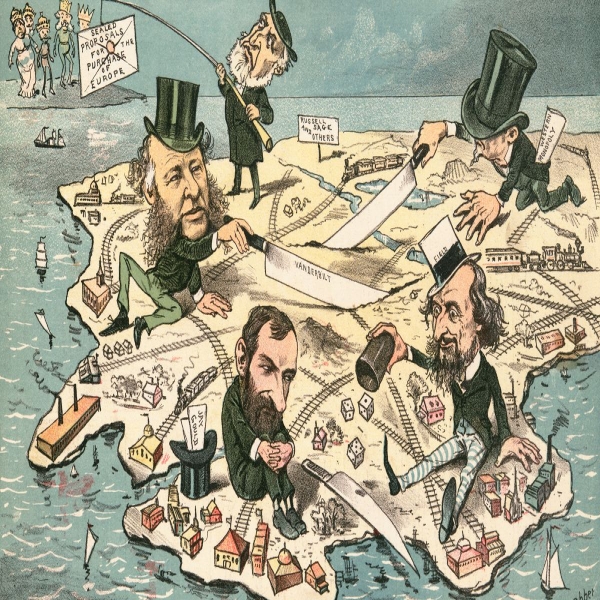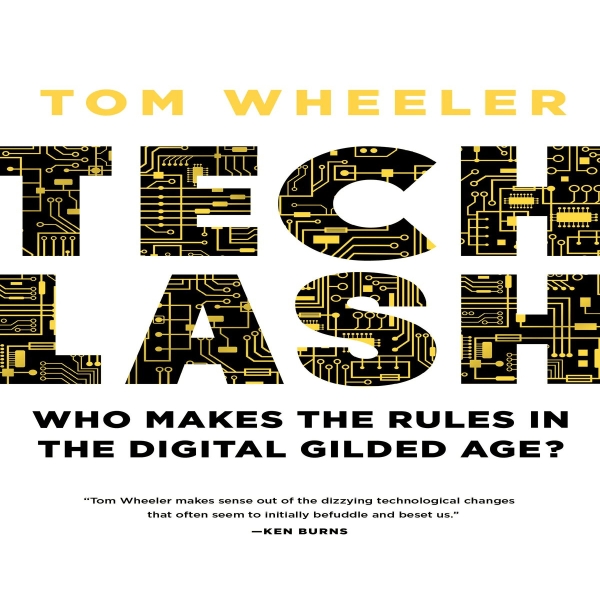Former FCC chair Tom Wheeler has a few ideas for how to regulate the “Digital Gilded Age.”

Sara Morrison is a senior Vox reporter who has covered data privacy, antitrust, and Big Tech’s power over us all for the site since 2019.
The 19th century probably isn’t the first thing that comes to mind when you hear about Big Tech’s harms and possible solutions. It’s probably not the second either, or even 50th. But in his forthcoming book Techlash: Who Makes the Rules in the Digital Gilded Age? Tom Wheeler makes the case that maybe it should be.
The original Gilded Age describes a period at the end of the 19th century and the beginning of the 20th, when it became increasingly apparent that new, transformative technologies that had done so much for so many had done a lot more for a very few: the handful of men who owned or effectively controlled industries like steel, oil, and the railroads. The money and power they amassed often came at the expense of everyone else. Antitrust laws and federal agencies were created to stop abusive business practices. We still rely on them today.
But an increasing number of people think those institutions aren’t equipped to deal with who holds the money and power now: Big Tech companies like Amazon, Apple, Google, Meta, and Microsoft. They differ on what can or should be done about that, however, and so very little has been done. These companies continue to operate under the rules they’ve made for themselves, which aren’t necessarily in the best interests of the rest of us. Wheeler has a few ideas about the best way to approach governmental oversight in this Digital Gilded Age, as he calls it. And he knows a thing or two about it.
“My entire professional life has been about the intersection of public policy and new technology,” he says, including a stint as chair of the Federal Communications Commission (FCC) under President Barack Obama — a tenure that will likely be best known for instituting net neutrality to increase government oversight of broadband internet (which was later repealed under Trump, and now, under Biden, is being restored). He also describes himself as an “amateur historian.” All four of his books, including this one, are rooted in history.
But he doesn’t think regulators and lawmakers should respond to the digital economy the way they did to the industrial innovations of 150 years ago. This Digital Gilded Age has a few fundamental differences from the original one, and that, he says, means it has to be regulated differently, too. Ahead of the release of Techlash, which comes out October 15, Wheeler spoke to Vox about all of this. This interview has been edited for brevity and clarity.
Sara Morrison
How did this concept of two gilded ages come about?
Tom Wheeler
The more you look at the original Gilded Age, the more you say, “Wow, does that sound familiar!” Our technology-driven environment today echoes the original Gilded Age, principally because at its root it is the innovators who make the rules without regard for the consequences. We’ve always celebrated the fact that innovators make the rules. They should; they can see the future that none of the rest of us can see. All the great advances in science, technology, business, the arts, came from people who said, “We won’t obey the rules because we see something different.”
But ultimately, that behavior runs into the rights of individuals and the public interest. We saw that in the original Gilded Age, and the Congress responded with antitrust legislation, with the creation of the first federal regulatory agency, with the creation of legislation to protect against unsafe products. And the result of that was incredible growth in the economy and in those companies, as well as protection for consumers and competition.
I think we’re at that same kind of a hinge moment today. The theme of this book is that unregulated tech has a damaging effect on basic things such as privacy, competition, and truth. And you can put in place an agile oversight that will protect the average American and promote innovation by promoting competition. You can then end up rebalancing the public and the private interest. We did it before and we can do it again.
Sara Morrison
What are some of the key similarities between that Gilded Age and this one?
Tom Wheeler
They were technology-driven, and the application of that technology was defined by a handful of innovators who made the rules based on what was in their interest, rather than what was in the public interest. In both instances, wondrous new things were developed. But they brought with them negative consequences.
And lastly, they both have accelerated the pace of life. In the original Gilded Age, industrialization increased the pace of life from the agricultural-based economy that had existed before. And obviously, in the digital Gilded Age, that pace of life has increased even more.
Sara Morrison
But they’re not exactly the same.
Tom Wheeler
The assets behave differently. Industrial assets were things you could stub your toes on. Digital assets are soft assets. Industrial assets were expensive; digital assets are inexpensive. Industrial assets were used once and it’s gone. Digital assets can be used again and again. Industrial assets were rivalrous: if I have a ton of coal, you don’t. But digital assets can be shared. And the industrial assets were exhaustible: you could only use something once. In the digital environment, you can use it again and again and again. Every time you sign up for Facebook, you’re using the same software that somebody else signed up with. Every time you download Microsoft Word, you’re using the same software. It’s inexhaustible.
So the fact that the assets themselves are different created an economic activity that was different. In the industrial era, it was a pipeline production economy. A hard asset moved through the process until it rolled off the assembly line as a finished product. In the digital era, it is a platform-pairing process, where you create digital assets by pairing them with other digital assets to produce a product.
Sara Morrison
What do those differences mean when it comes to regulation?

Tom Wheeler
The question is not only how do we put guardrails around Big Tech, but also how do we do it in a way that continues to encourage innovation? Industrial-style regulation is like industrial-style management. When Congress went to create these industrial agencies that we know today, including the FCC, they looked at how the companies that were to be supervised were being managed. Industrial management was a top-down, rigid, rules-based approach. The guru of industrial management was a fellow by the name of Frederick W. Taylor, and his management techniques were called Taylorism. Basically, his idea was to squeeze all creativity out of everybody, and get them to do exactly the same thing by your rules. And that will give you the best industrial production.
It is just the opposite today. Not only are our companies managed by agile management techniques, in that they’re constantly having to respond to new technology, but they’re also constantly having to respond to marketplace changes. What we need to have are new regulators that look like the new style of agile digital management that exists today.
Sara Morrison
You literally ran an agency, the FCC, that came out of that old model. Did your experience there inform your opinion now? Can agencies like the FCC even be agile?
Tom Wheeler
I had to bring agility to an agency that was designed not to be agile. The net neutrality rule has what’s called the general conduct rule component, which builds in agility to deal with what might happen next. The privacy rule had agility in it to deal with changes. And what we did in cybersecurity was designed from the outset to be agile, because the bad guys who are trying to crack the security of networks are themselves incredibly agile. Unfortunately, all three of those were repealed in the Trump administration.
But, yes, I tried to practice this. Part of the reason why I wrote this book was to convey those learnings and what other solutions might be.
Sara Morrison
You use words like “sclerotic” and “rigid” to describe some of the things we have in place to deal (or not deal) with these matters. Can I assume that you don’t think Congress can or will do the job this time?
Tom Wheeler
I think that they will, eventually. Here’s the important thing, another historical analogue: It was in 1867 that the Grange was founded by farmers as a countervailing force to the power of the railroads. Railroads were abusing farmers, and the farmers kept saying, “We need oversight.” But it wasn’t until 1887, 20 years after the Grange was founded, that the Interstate Commerce Commission was created. And it wasn’t until almost 20 years after that that Teddy Roosevelt finally helped to give it some real enforcement teeth. So the point of the matter is, this always takes a long period of time.
I think it needs to move faster now because of the even faster pace of life created by the new technology. I am optimistic that as the American people continue to express themselves about the need for oversight, that Congress will respond.
Sara Morrison
Will it? Big Tech companies have a lot of money to spend on lobbyists and whatever else. It seems like that’s been pretty effective at convincing them not to do much of anything so far.
Tom Wheeler
So everybody says, “Oh, Congress is so controlled by the special interests.” But special interests in the late 19th century owned members of Congress. And still, we had antitrust laws, we had consumer protection laws. I think that, today, we the people need to communicate. The reason things changed in the late 19th century was that we the people, folks like the Grange, folks like the progressive movement and populists, kept saying, “This is enough. We’ve got to do something about that.” And I think that’s the hope for us, in our time.
Sara Morrison
You give Teddy Roosevelt a lot of credit for Gilded Age reforms in the book. Who is our Teddy Roosevelt now?
Tom Wheeler
There is no one today with Rooseveltian powers and instincts. I think that President Biden has done more to promote competition and have oversight of digital activities than most other presidents in the digital era. And I would hope that someday he will be signing a digital protection agency bill. But I mean, through his appointments with people like [FTC chair] Lina Khan, those were inspired kinds of activities that have effects.
Sara Morrison
So, what does the ideal government oversight look like to you?
Tom Wheeler
We need an agile agency that has a new approach and is built to look like the companies that it is supposed to oversee, rather than built to look like industrial companies that are not part of the digital economy. It’s reverse Taylorism. Where Taylor said we want to squeeze out every incentive for creativity, in digital companies transparency and creativity are the watchwords. We need to have those same concepts as the watchwords in the oversight of those digital companies.
Sara Morrison
One of your legacies at the FCC is net neutrality, which is back! Why do you think it’s become such a contentious issue? It seems reasonable to me that, as a technology becomes more and more essential to our lives, there should be more oversight ensuring that we all have access to it.
Tom Wheeler
I think the real answer to that question is because the companies are afraid that it will lead to rate regulation, which they’re scared to death of. And, as you know, in our Open Internet Order, our net neutrality rule, we specifically said we’re not going to enforce rate regulation.
Sara Morrison
Why not have rate regulation?
Tom Wheeler
The thought process that I went through in making that decision was: I can see how you can regulate a single factor like a voice line. I think it is entirely different to regulate a multifactor service like broadband that is constantly changing. So, it was in large part because A) we didn’t see the need for it today; B) we wanted to encourage broadband expansion; and C) we didn’t know how to do it. A broadband line delivers so much more than a voice channel, so how do you prioritize that? How do you decide that this is going to be priced this way, that’s going to be priced that way? And increasingly, broadband is competitive.
Having said that, I didn’t want to make the decision that would saddle my successors down the road who might have a need to do something about abusive pricing. I don’t think we’re experiencing that now. And so we said the power is there, but we’re not going to enforce it.
A version of this story was also published in the Vox Technology newsletter. Sign up here so you don’t miss the next one!
Source: vox.com





